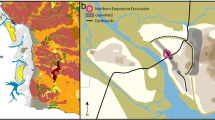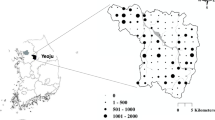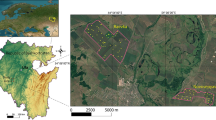Abstract
Data on the fractional and group composition of humus in urban soils of Rostov-on-Don are discussed. We have compared the humus profiles of chernozems under tree plantations and those buried under anthropogenic deposits (including sealed chernozems under asphalt). It is shown that the type of humus in these soils remains stable despite a decrease in its total content after the long-term burial under asphalt. Under the impact of the trees, the organic matter of the chernozems acquired some features typical of gray forest soils, i.e., the humate-fulvate type of humus in the humus horizon and the sharp drop in the humus content down the soil profile.
Similar content being viewed by others
References
B. P. Akhtyrtsev, Gray Forest Soils of Central Russia (Voronezh, 1979) [in Russian].
O. S. Bezuglova, “Composition of humus in chernozems and chestnut soils of Rostov oblast,” Pochvovedenie, No. 12, 70–74 (1978).
O. S. Bezuglova, S. N. Gorbov, and V. V. Privalenko, “The humus profile and the microelemental composition of soils in the recreational areas of Rostov-on-Don,” Eur. Soil Sci. 33(9), 1001–1006 (2000).
O. S. Bezuglova, S. N. Gorbov, I. V. Morozov, and D. G. Nevidomskaya, Urbopedology (Izd. YuFU, Rostov-on-Don, 2012) [in Russian].
O. S. Bezuglova and N. V. Yudina, “Interrelationship between the physical properties and the humus content of chernozems in the south of European Russia,” Eur. Soil Sci. 39(2), 187–194 (2006).
M. S. Bruk, “On the evolution of chernozems under human impact,” Pochvovedenie, No. 3, 3–12 (1975).
M. I. Gerasimova, “Micromorphological diagnostics of elementary pedogenetic processes,” Pochvovedenie, No. 11, 105 (1985).
M. I. Gerasimova and T. L. Bystritskaya, “The impact of land use on the microfabric of ordinary chernozems,” in Micromorphology of Anthropogenically Transformed Soils ( (Nauka, Moscow, 1988), pp. 46–55 [in Russian].
M. I. Gerasimova, M. N. Stroganova, N. V. Mozharova, and T. V. Prokof’eva, Anthropogenic Soils: Genesis, Geography, and Rehabilitation (Oikumena, Smolensk, 2003) [in Russian].
F. Ya. Gavrilyuk, Chernozems of the Western CisCaucasus (Kharkov, 1955) [in Russian].
S. N. Gorbov, Extended Abstract of Candidate’s Dissertation in Biology (Rostov-on-Don, 2002).
S. N. Gorbov and O. S. Bezuglova, “Elemental composition of humic acids in urbanized soils,” Pochvovedenie, No. 11, 1316–1324 (2013).
N. V. Goryainova, Extended Abstract of Candidate’s Dissertation in Biology (Moscow, 1995).
M. I. Dergacheva, Soil Organic Matter: Statics and Dynamics (by the Example of Western Siberia) (Novosibirsk, 1984) [in Russian].
S. A. Zakharov, Soils of Rostov Oblast and Their Agronomic Characterization (Rostov-on-Don, 1946) [in Russian].
D. S. Orlov, Soil Humus Acids and a General Theory of Humification (Moscow, 1990) [in Russian].
D. S. Orlov and M. F. Ovchinnikova, “Different forms of nitrogen compounds in sierozem, chernozem, and soddy-podzolic soil,” Agrokhimiya, No. 1, 35–44 (1966).
T. A. Plotnikova and N. E. Orlova, “Application of a modified scheme of Ponomareva-Plotnikova for determination of the composition, nature, and properties of soil humus,” Pochvovedenie, No. 8, 120–130 (1984).
V. V. Ponomareva and T. A. Plotnikova, Humus and Soil Formation (Nauka, Leningrad, 1980) [in Russian].
A. I. Popov, Humic Substances: Properties, Structure, and Origin (Izd. SPbGU, St. Petersburg, 2004) [in Russian].
T. V. Prokof’eva, S. A. Sedov, M. N. Stroganova, and A. A. Kazdym, “An experience of the micromorphological diagnostics of urban soils,” Eur. Soil Sci. 34(7), 783–792 (2001).
T. V. Prokof’eva, M. S. Rozanova, and V. O. Poputnikov, “Some features of soil organic matter in parks and adjacent residential areas of Moscow,” Eur. Soil Sci. 46(3), 273–283 (2013).
M. N. Stroganova, A. D. Myagkova, and T. V. Prokof’eva, “The role of soils in urban ecosystems,” Eur. Soil Sci. 30(1), 82–86 (1997).
V. A. Kholodov, A. I. Konstantinov, E. Yu. Belyaeva, N. A. Kulikova, A. V. Kiryushin, I. V. Perminova, “Stroenie guminovykh kislot, izvlekaemykh v khode posledovatel’noi shchelochnoi ekstraktsii iz tipichnogo chernozema,” Pochvovedenie, No. 10, 1177–1183 (2009).
S. N. Chukov, Strukturno-funktsional’nye parametry organicheskogo veshchestva pochv v usloviyakh antropogennogo vozdeistviya (Izd-vo SPbGU, St. Petersburg, 2001) [in Russian].
W. Burghardt, “Urban Soils and Construction Sites,” Encyclopedia of soil cience. N.Y., USA: Marcel Dekker, 1362–1366 (2002).
L. B. Byrne, “Habitat Structure: a Fundamental Concept and Framework for Urban Soil Ecology,” Urban Ecosyst 10, 255–274 (2007).
A. Chabbi, C. Rumpel, and I. Kogel-Knabner, “Stabilised Carbon in Subsoil Horizons Is Located in Spatially Distinct Parts of the Soil Profile,” Soil Biol. Biochem. 41, 256–261 (2009).
E. Gruneberg, I. Schoning, E. K. V. Kalko, and W. W. Weisser, “Regional Organic Carbon Stock Variability: A Comparison Between Depth Increments and Soil Horizons,” Geoderma 155, 426–433 (2010).
I. Kögel-Knabner, “Analytical Approaches for Characterizing Soil Organic Matter,” Organic Geochemistry 31, 609–625 (2000).
I. Kögel-Knabner, “The Macromolecular Organic Composition of Plant and Microbial Residues As Inputs To Soil Organic Matter,” Soil Biol. Biochem. 34, 139–162 (2002).
K. Lorenz and E. Kandeler, Biochemical Charaterization of Urban Soil Profiles From (Germany // Soil Biol. Biochem, Stuttgart, 2005), Vol. 37.
K. Lorenz and R. Lal, “Biogeochemical C and N Cycles in Urban Soils,” Environment International 35, 1–8 (2009).
R. Pouyat, P. Groffman, I. Yesilonis, and L. Hernandez, “Soil Carbon Pools and Fluxes in Urban Ecosystems,” Environ. Pollut. 116, 107–118 (2002).
I. V. Perminova, F. H. Frimmel, A. V. Kudryavtsev, N. A. Kulikova, G. Abbt-Braun, S. Hesse, V. S. Petrosyan, “Molecular Weight Characteristics of Aquatic, Soil, and Peat Humic Substances As Determined by Size Exclusion Chromatography and Their Statistical Evaluation,” Environ. Sci. Technol. 37, 2477–2485 (2003).
M. W. I. Schmidt, J. O. Skjemstad, E. Gehrt, and I. Kögel-Knabner, “Charred Organic Carbon in German Chernozemic Soils,” Eur. J. Soil Sci 50, 351–365 (1999).
Author information
Authors and Affiliations
Corresponding author
Additional information
Original Russian Text © S.N. Gorbov, O.S. Bezuglova, 2014, published in Pochvovedenie, 2014, No. 8, pp. 953–962.
Rights and permissions
About this article
Cite this article
Gorbov, S.N., Bezuglova, O.S. Specific features of organic matter in urban soils of Rostov-on-Don. Eurasian Soil Sc. 47, 792–800 (2014). https://doi.org/10.1134/S1064229314080043
Received:
Published:
Issue Date:
DOI: https://doi.org/10.1134/S1064229314080043




